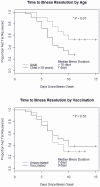Influenza transmission in a cohort of households with children: 2010-2011
- PMID: 24086511
- PMCID: PMC3783407
- DOI: 10.1371/journal.pone.0075339
Influenza transmission in a cohort of households with children: 2010-2011
Abstract
Background: Households play a major role in community spread of influenza and are potential targets for mitigation strategies.
Methods: We enrolled and followed 328 households with children during the 2010-2011 influenza season; this season was characterized by circulation of influenza A (H3N2), A (H1N1)pdm09 and type B viruses. Specimens were collected from subjects with acute respiratory illnesses and tested for influenza in real-time reverse transcriptase polymerase chain reaction (RT-PCR) assays. Influenza cases were classified as community-acquired or household-acquired, and transmission parameters estimated.
Results: Influenza was introduced to 78 (24%) households and transmission to exposed household members was documented in 23 households. Transmission was more likely in younger households (mean age <22 years) and those not reporting home humidification, but was not associated with household vaccination coverage. The secondary infection risk (overall 9.7%) was highest among young children (<9 years) and varied substantially by influenza type/subtype with the highest risk for influenza A (H3N2). The serial interval (overall 3.2 days) also varied by influenza type and was longest for influenza B. Duration of symptomatic illness was shorter in children compared with adults, and did not differ by influenza vaccination status.
Discussion: Prospective study of households with children over a single influenza season identified differences in household transmission by influenza type/subtype, subject age, and home humidification, suggesting possible targets for interventions to reduce transmission.
Conflict of interest statement
Figures


References
-
- Longini IM Jr, Nizam A, Xu S, Ungchusak K, Hanshaoworakul W, et al. (2005) Containing pandemic influenza at the source. Science 309: 1083–7. - PubMed
-
- Committee on Modeling Community Containment for Pandemic Influenza and Institute of Medicine (2006) Modeling community containment for pandemic influenza: A letter report. Available: http://books.nap.edu/catalog/11800.html#orgs. Accessed February 13, 2013.
Publication types
MeSH terms
Grants and funding
LinkOut - more resources
Full Text Sources
Other Literature Sources
Medical

